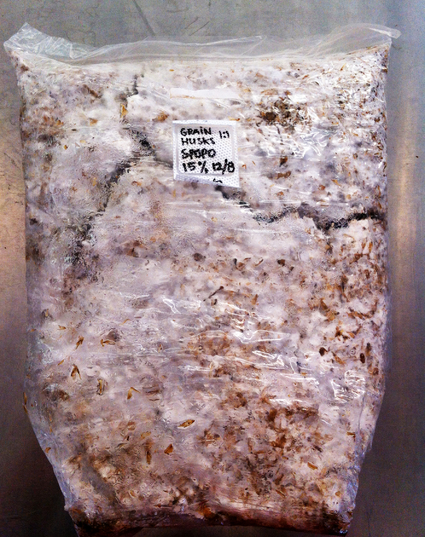Using waste is just one of Mediamatics’ main traits. So in this spirit, at the Mycoinsulation Brewery, we perceive waste as a potential material, and have put this into practice by re-using discarded Cacao jute sacks, their content: cacao husks, and spent beer grain from our beer brewing activities.
In this article we will tell you about how we are growing mycelium spawn on beer grain, and what to expect if you try it yourself!
Normally breweries have masses of spent grain to dispose of, and they have to pay for it to be collected. It is sometimes used as compost or given to farmers for their livestock (e.g Pig feed). We, however want to grow mycelium on it, to make insulation material for one of our buildings.
Since we have been trying this, we have found that there are at least two issues with using spent beer grain as a substrate for mushroom growth:
1.too acidic
So regulating Ph toward a more alkaline state by adding sterilised chalk is one solution.
2. too wet
It’s just too wet for the mycelium to grow successfully. - So we squeeze the grain, but we would like to try using a centrifugal spinner to reduce this extra moisture.
Onto the How!
We start with brewing our beer. We keep the grains in the wort for the cooking phase after mashing to pasteurise them. Once the hot and wet grains have been removed from the wort, it is time to remove as much of that moisture as possible.
We then prepare four grow bags and fill each one with an additional substrate. This is what we are testing: which mixture does the mycelium like the most?
We add the grain to the substrate in the grow bags, and place them in a pressure cooker. This cooks for 2hours at 15psi pressure. We remove the sterile grain-substrate bags from the pressure cooker, and let them cool down before inoculating the bags with commercial spawn.
With the bags of sterilised substrate mix & beer grain now cool and in the clean room, we open them, and add the chalk to balance the Ph, and add the mycelium.
We add 15% (of the substrates volume) of spawn to the substrate mixtures each, and then re-seal the bags with a vacuum sealer. After a shake and a mix, we place them in temperature regulated space. Here they grow, eating the beer grain and turning it into a connected mass of mycelium material!
So what are the substrate mixes that we are testing?
Bag Top left: 4 litres of Grain only (helps to compare)
Bag Top right: 2 litres of Grain & 2 litres Cacao
Bag Bottom left: 2 litres of Grain & 2 litres Sawdust
Bag Bottom right: 2 litres of Grain & 2 litres Husks
Each inoculated with 15% Spopo commercial spawn.
How are they each growing?
After 7 days:
The wettest is the grain-only bag. It has some mycelium growth on the surface, but it's not penetrated the substrate enough to see any growth on the reverse. Just too wet!

The Cacao mixture has mostly just clumped growth and has not connect together.
The Sawdust has grown well, but it is breaking into clumps easily, so not that solid bonding yet.
The husks mixture shows the most promising results so far, with plenty of growth, and it has bonded well into a well connected structure. It is also the lightest of the 4 bags.

What are the next steps?
We continue to see if we can repeat these results, and if a centrifugal spinner will help remove the excess moisture! Then if the husks continue to ‘shine’, we will scale up and enlarge the quantities, to make our own spawn for the insulation panels.
